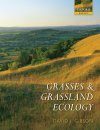By: David J Gibson(Author)
305 pages, colour plates, illustrations, tables
![Grasses and Grassland Ecology Grasses and Grassland Ecology]()
Click to have a closer look
About this book
Customer reviews
Related titles
About this book
Grasslands, in particular managed pastures and rangelands, are widespread, covering approximately 40% (52 million km2) of the Earth's land surface. They are dominated by members of the Poaceae - the fourth largest plant family with over 7,500 species, and also the most widespread. Grasslands constitute a major biome on all continents except Antarctica and also represent the most important food crop on Earth with corn, wheat, maize, rice and millet accounting for the majority of our agricultural output.
Grasses and Grassland Ecology provides an ecologically orientated introduction to this influential group of plants, summarizing the most recent scientific research in ecology and agriculture in the context of the older, classic literature. Ten chapters cover the morphology, anatomy, physiology and systematics of grasses, their population, community and ecosystem ecology, their global distribution, and the effects of disturbance and grassland management.
This comprehensive and accessible textbook is suitable for graduate level students as well as professional researchers in the fields of plant ecology, rangeland science, crop science, and agriculture.
Customer Reviews
By: David J Gibson(Author)
305 pages, colour plates, illustrations, tables
"An accomplished textbook that offers readers a carefully crafted, well-structured, and very readable expose of grasslands, their significance, function, and management. Gibson covers a very broad suite of subject material, which I consider one of this work's major strengths. There is great deal to like about this book. I would gladly recommend it to any student, landholder, policymaker, or restorationist whose interest or passions are drawn to the beauty of grasslands."
- The Quarterly Review of Biology
"The scope of this book is considerable and the author is to be congratulated on his synthesis [...] This is a useful and welcome addition to an grassland library, bridging the gap between ecology texts and more agriculturally focused grassland science texts."
- Grass and Forage Science







































